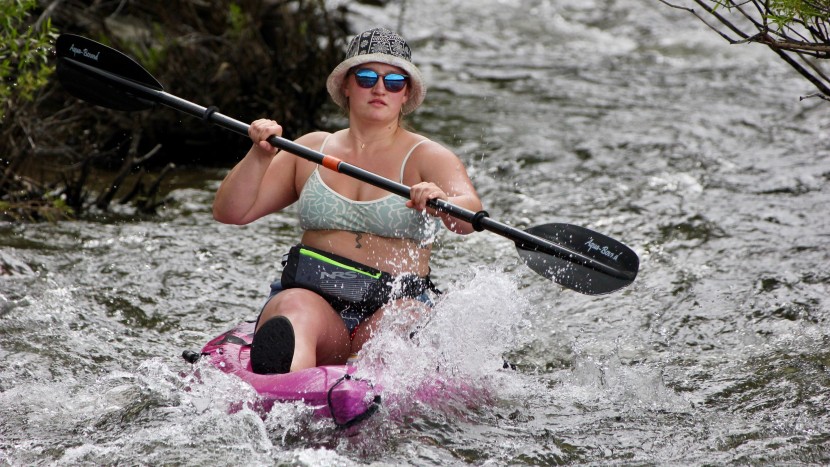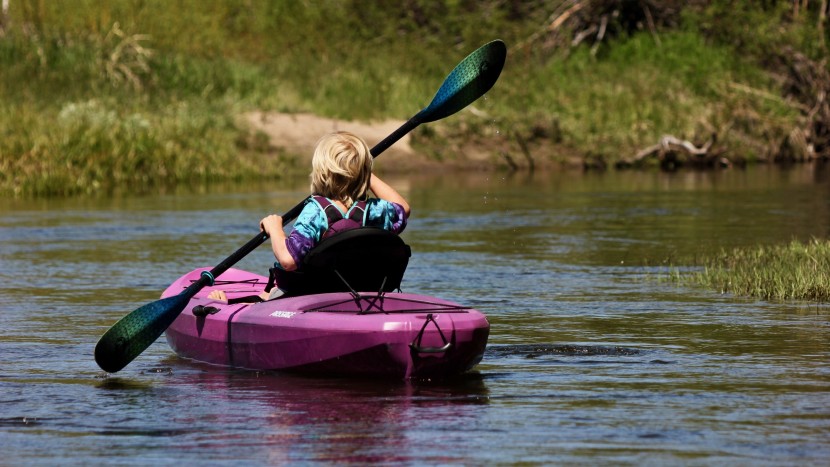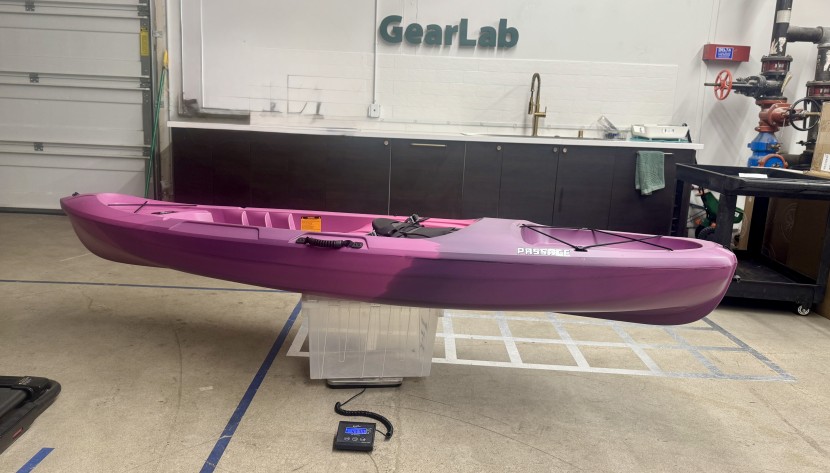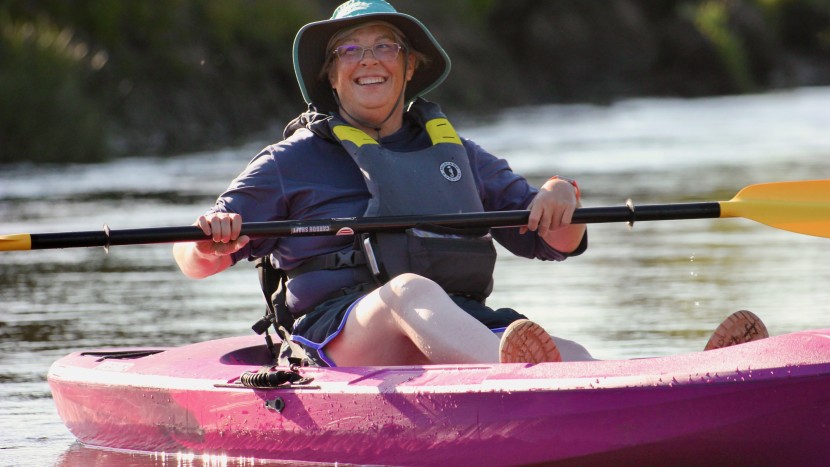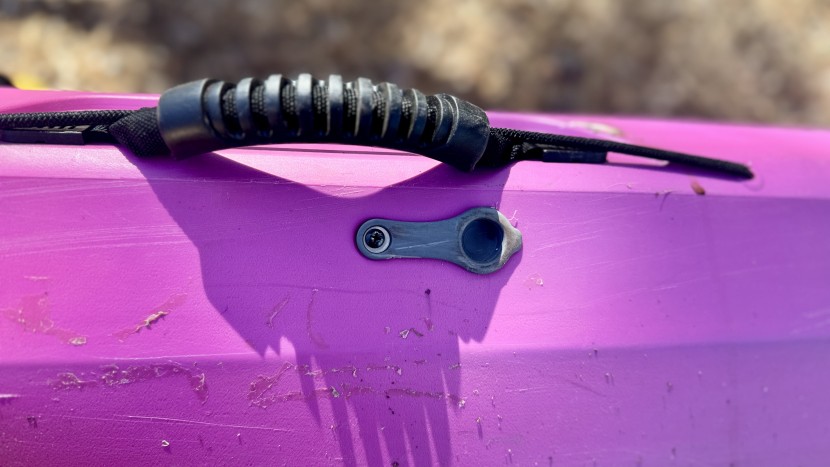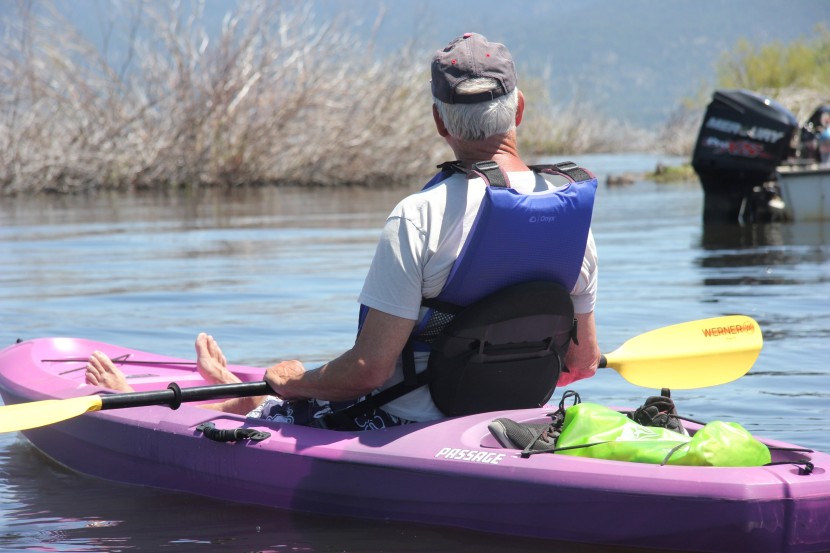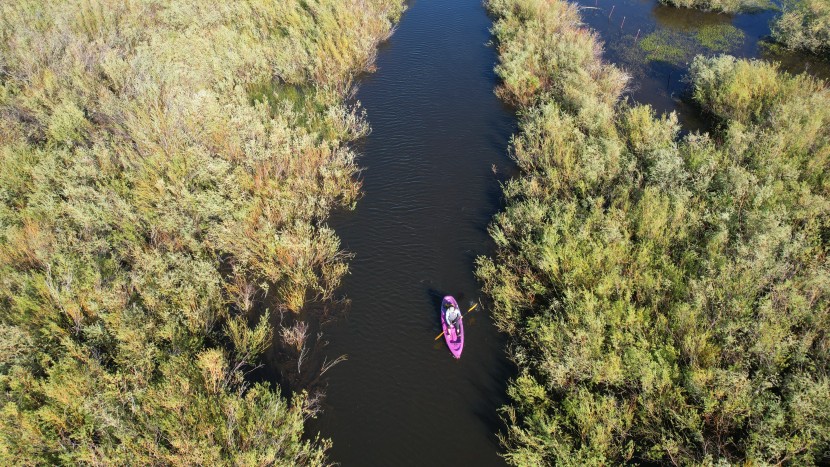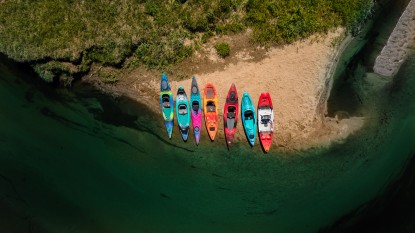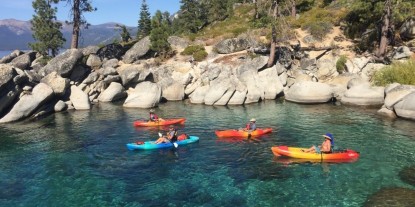
Our Verdict
Our Analysis and Test Results
The Quest Passage 100 is 9.75 feet long, with a 31-inch-wide hull. It has an adjustable padded seat, molded footrests, a paddle keeper, and front and rear bungee storage areas. It weighs 48 lbs and has carry handles on the front, back, and sides.
Glide and Tracking
At just under 10 feet in length (9 feet 9 inches), the Passage 100 is designed more for maneuverability than long-distance efficiency. Its short and wide profile means it tracks well enough for lakes and mellow rivers, though it won't cut through waves or wind as effectively as longer, narrower boats.
The flat hull provides solid primary stability, while a slightly pointed bow helps it glide through flatwater with minimal effort. Though not a speedster, its performance is sufficient for casual paddling and new users learning the ropes. While tracking is passable in calm conditions, more experienced paddlers may notice it drifting slightly in between strokes or when paddling into a headwind. For those planning to cover distance or navigate strong currents, a kayak with a longer waterline or skeg might be a better fit.
Stability
Stability is one of this kayak's standout strengths. The wide hull keeps paddlers steady, even when entering, exiting, or shifting weight. It's a forgiving platform for beginners and casual paddlers, offering a reassuring ride in smooth conditions.
Its 275-pound capacity is adequate for most casual uses, though mega-haulers may find it limiting. Notably, this capacity is on the low end for harshell kayaks. Overall, the Passage 100's stability inspires confidence, especially for those new to kayaking.
Maneuverability
The compact design and absence of a deep keel allow the Passage 100 to pivot quickly and navigate tight turns with ease.
Whether you're exploring narrow inlets or weaving through shoreline obstacles, this boat responds well to basic paddle strokes. Its lightweight and responsive turning also make it a great choice for smaller paddlers or kids, who may struggle to control larger boats.
The open cockpit and sit-on-top design also make it easy to remount from the water, making it a friendly option for beginners or families. If you do capsize this boat, it is easier than most to rewrite, and the four scupper holes enable it to drain relatively quickly.
Ease of Transport
Weighing 48 pounds, the Passage 100 is decently easy to transport. Although there are lighter kayaks on the market, the plastic-covered end handles make two-person carrying a breeze, with our testers finding it easier to carry than lighter kayaks that use basic string handles. The side handles are also exceptionally convenient for solo maneuvering and storing this kayak leaning on its side.
With an inconveniently located balance point, this kayak is awkward for one person to shoulder carry. However, the flat hull and durable construction enable the Quest to withstand short-distance dragging well. Although a kayak cart can make longer hauls more pleasant, it is still manageable without one.
Comfort
Surprisingly comfortable for the price, the kayak features a padded seat with an adjustable backrest that supports moderate-length paddles. Molded footwells accommodate different leg lengths without the need for adjustments.
A molded bottle and phone holder, along with a paddle keeper, add practical value, helping paddlers stay organized on the water without incurring extra costs.
While the seat performs admirably for short outings, it may start to feel less supportive during longer sessions, especially for paddlers with back issues. The back of the seat has adequate padding, but the bottom of the seat is very thinly padded and is prone to coming loose. Adding a gel pad or seat upgrade could enhance comfort for those planning extended use. Some testers also noticed that their legs tended to catch on the narrow seat adjustment straps, which can be frustrating and also cause the backrest to loosen.
Construction Quality
Made from rotomolded polyethylene, the Passage 100 is built to withstand routine bumps and scrapes. While it lacks the polish, fit-and-finish of higher-end kayaks, its durability and simplicity are relative strengths compared to other budget kayaks.
Open storage wells at the bow and stern provide space for dry bags or small gear, and a spot has been molded into the rear storage well specifically designed to fit a 5-gallon bucket. Despite these conveniences, the lack of enclosed dry storage may be a drawback for those seeking more security or weather protection.
One notable weak point is the attachment holes that the bungee cords pass through, which are not sealed. This allows water to seep into the kayak as it's hit by waves or left out in the rain. There are front and rear drain plugs — though they require a flat-headed tool to remove. There's also a more convenient side drainage port under the right side handle that can be opened by hand, allowing for easy emptying of any water that makes its way inside the kayak shell.
Despite its budget status, the Passage proved itself to be solid and reliable for regular use. Users have reported minor issues, such as fading over time or loose seat straps, but overall, it holds up well with basic care and storage.
Should You Buy the Quest Passage 100?
If you're looking for an affordable, stable, and easy-to-use kayak for relaxed paddling on calm waters, the Quest Passage 100 delivers solid value. While it doesn't include premium storage or performance features, it checks all the boxes for casual users and beginners who want a reliable and enjoyable ride without the high price tag. It's best suited for flatwater paddling on lakes, bays, and calm rivers, especially for those new to kayaking or seeking a fuss-free weekend option.
What Other Kayaks Should You Consider?
The Passage 100 excels in stability and comfort for a reasonable price, but paddlers seeking a closed cockpit design with sealed storage may be interested in the equally budget-friendly Pelican Argo 100X EXO. If you are willing to invest more money for a reliable and enjoyable sit-on-top kayak, the Ocean Kayak Malibu 11.5 offers comfortable seating, great stability, and significantly improved tracking. However, for beginners on a budget, the Passage 100 remains a smart and straightforward choice.
| Awards | Best Bang for the Buck |
|---|---|
| Price | $350 List |
Overall Score  |
|
| Star Rating | |
| Bottom Line | This budget-friendly sit-on-top kayak delivers a stable, easy-to-maneuver ride and comes equipped with a range of convenient features for casual paddlers |
| Pros | Spacious, affordable, paddle keeper, good for casual paddling |
| Cons | No secure dry storage, basic quality of construction, seat prone to move |
| Rating Categories | Quest Passage 100 |
| Glide and Tracking (30%) | |
| Stability (20%) | |
| Maneuverability (15%) | |
| Ease of Transport (15%) | |
| Comfort (10%) | |
| Construction Quality (10%) | |
| Specifications | Quest Passage 100 |
| Measured Length | 9.75' |
| Measured Width | 31.0" |
| Measured Weight | 48 lb |
| Measured Height | 13.5" |
| Weight Capacity | 275 lb |
| Material/Construction | Low-density and high-density polyethylene |
| Features | Adjustable padded seat, rear open storage well, self bailing scupper holes, molded in water bottle and phone grooves, paddle keeper, bow and stern bungees |



